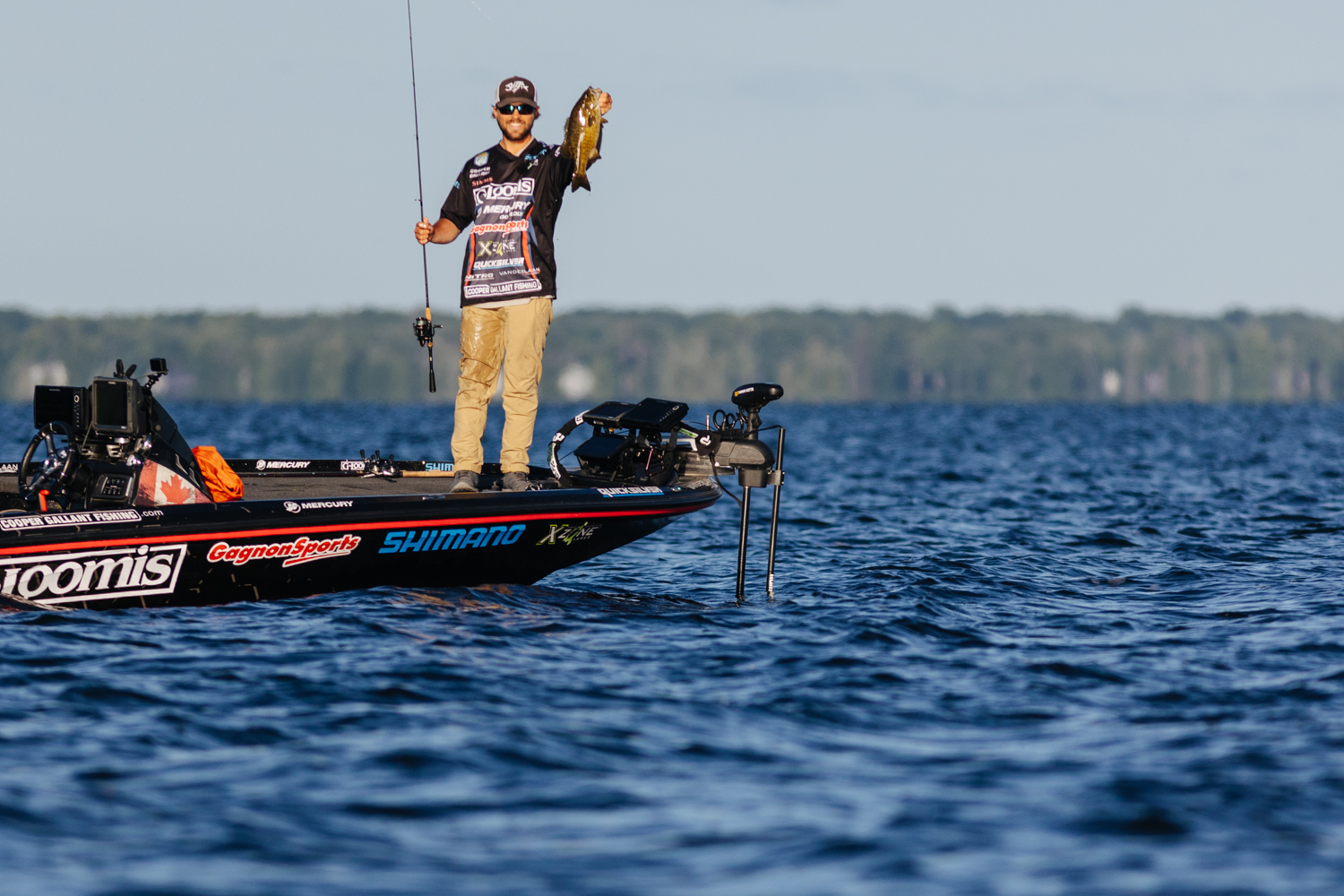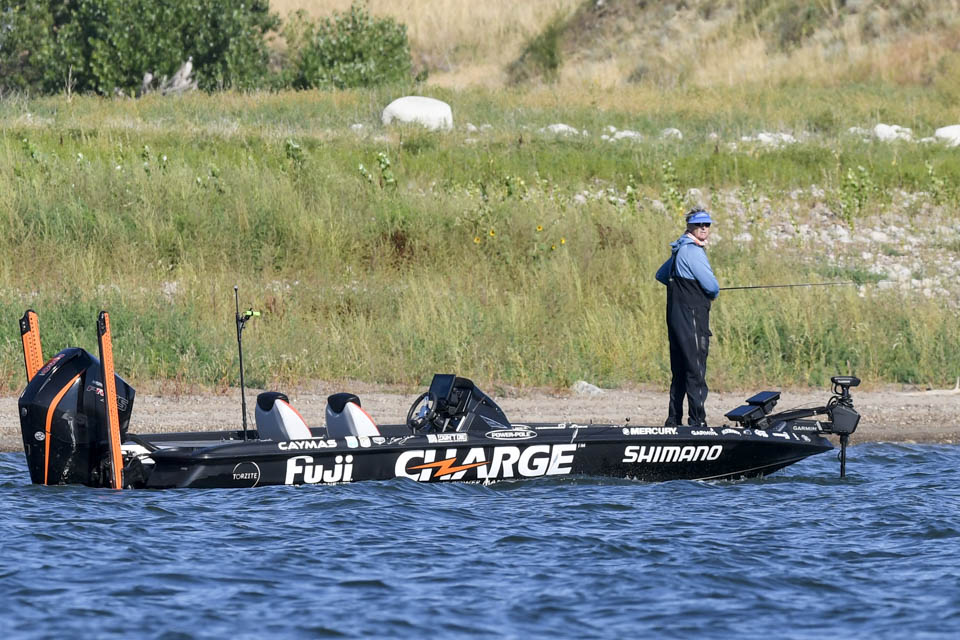
It’s a natural assumption; we tend to equate northern smallmouth with deeper water. But while there’s no lack of opportunity in flogger depths, don’t overlook the areas that would leave a basketball rim dry.
The spawn obviously pulls a lot of big ones up shallow enough to sight fish. Tons of fun, no doubt, but bed fish are not always the easiest.
Canadian pro and Elite rookie Cooper Gallant knows that postspawn through the summer months will offer plenty of chances to locate and engage these brown brutes in 10 feet or less.
“In northern fisheries, there’s always going to be big smallmouth shallow,” Gallant said. “They get shallow in the fall before they start going out (to wintering depths).
“Realistically, there are shallow smallmouth all year long. It’s not that they stay shallow; a lot of times, it’s a timing deal. They’ll come up shallow to feed, but sometimes, smallmouth just like having sun on their backs.”
No question, these feisty fish pretty much do what they want and, as veteran Elite Bernie Schultz said, it’s simply a matter finding fish and realizing that relocation is common.
“There are fish that become territorial — they’ll set up on different shoals and sand bars and structural features, but a lot of them come up periodically and go back,” he said.

Where to look
In most northern lakes and rivers, Gallant expects to find shallow smallies on expansive flats next to deep water. That could be a river or lake scenario; it’s all about the access. Smallies want to easily reach the food, while remaining close to safer depths
Gallant likes a flat with rock transitions and shallow sandy areas. Schultz, who has historically fared well on the St. Lawrence River by fishing flats shielded by current-breaking islands, agrees and notes habitat diversity bolsters the appeal.
“The best ones usually are a mix of rock, sand and grass. I think whenever you have a variety off cover and structural features, it’s a magnet for food — baitfish, craws, etc.
“The most attractive islands are the ones with a diversity of composition and plenty of bait.”
Wherever smallies roam shallow, the common thread defines their primary interest — food. Gobies, alewives, shiners and crawdads rank high on the list, but Gallant points out another entree class — one that helps explain why those black marabou “hair” jigs work so well.
“They’ll eat a bunch of insect larvae, little bugs, stoneflies, mayflies,” Gallant said. “I think that’s something that, quite often, gets overlooked.”

Windows of opportunity
Gallant and Schultz have both learned that the shallow smallmouth action typically comes in spurts. Unlike tidal waters, where current and depth fluctuations define the most likely times, this game offers less predictability. Typically, persistence proves most productive.
“Sometimes, you will figure it out on certain bodies of water, but a lot of the time, you just keep going back,” Gallant said. “You might see them there one day at 10 in the morning; you might see them one day at 2 in the afternoon.
“They get on some sort of a schedule, but it’s like us — we don’t always eat dinner at the same time every single night. Just because they’re not there one hour doesn’t mean they’re not going to be there the next hour.”
Weather and sky conditions will influence when the fish come and go, but as Gallant points out, nasty weather will shut down the shallow bite.
“On Lake Ontario, if you have 7- to 8-footers rolling onto a flat that’s only 10 feet deep, that might stir things up and push the fish off,” he said.
On the flipside, a sunny day with moderate chop has Schultz feeling optimistic.
“In the South, they like overcast days, nasty days,” he said. “Up north, they like sun, they like wind and they’re pretty aggressive when you get that combination.
Rules of the road
A few points to consider when targeting shallow northern smallmouth.
Distance is your friend: The extreme clarity characteristic of northern waters complicates the cat-and-mouse game. A shallow smallie might not bolt, but you’re not fooling them. It’s just a matter of tolerance.
“There are times when they can be very hard to catch. A lot of the times, they don’t look spooked like a largemouth would, they’re more mellow. But if they know you’re there, they get stubborn.”
Schultz agrees and notes that downwind and/or down sun casts equal stealth. Moreover, daily conditions can help or hinder, depending on the objective.
“I like a light wind if I’m sight fishing smallmouth, but if I’m just covering water, more breeze breaks up the surface and cushions their awareness of you,” Schultz said. “I try to make out the fish as soon as I can and, if they’re not moving, I’ll drop the Power-Poles and make long casts.”
Gallant manages the intrusion risk by easing onto a flat, fancasting and watching for visible targets. A sensible strategy, this incremental tactic also leverages that clarity to his advantage.
“When the water’s clear, if your bait lands within 20 of that fish, it knows that bait is there, and if that fish wants to eat, it’s going to come over an eat,” Gallant said. “You don’t need to land right on their head.
“A lot of anglers will get on a flat and they can’t help themselves but to get up there and see if the fish are there. You just gotta be patient and stay back and have the confidence that they’re up there.”
Quality over quantity: Schultz prefers hunting shallow smallmouth on the Great Lakes and the St. Lawrence River because it allows him to better gauge the size potential.
“There are fewer fish shallow and a lot of times, I’m fishing for rogue fish,” he said. “There might be one an hour, but usually, they’re the right size fish.”
Give it time: Forward facing sonar helps instill that confidence, while eliminating unproductive areas. If he believes in an area, Gallant will work it into his rotation and visit the area multiple times throughout the day to determine when the fish move up to feed.
Likewise, after catching a few, he’ll let the spot rest, in hopes of reloading. That potential, Gallant said, depends on the area.
“If it’s close to deep water and there’s a highway for more fish to move in, it will reload,” Gallant said. “But if it’s a flat in the back of a pocket farther away from deeper water, that might not reload as much.”
How to get ’em
Gallant’s fancasts his shallow smallmouth baits with a spybait and an Outkast Tackle Feider Fly. Schultz keeps an array of offerings handy, with a Hildebrandt Drum Roller swimbait, a Shimano World Pop, Shimano World Minnow (jerkbait), a Rapala Skitterwalk and a Yamamoto D-Shad handling most of his recon efforts.
For targeting his dialed-in areas, Schultz likes a selection of Ned rigs, drop shots, jigs and tubes.
With the exception of his moving baits, Schultz fishes most of his shallow smallmouth presentations on a 7-2 medium-heavy Shimano Poison Ultima spinning rod with a Shimano Stradic or Stella spinning reel carrying 10-pound Power Pro Super 8 Slick braid. Schultz tops his braid with 8- to 10-pound Shimano Mastiff fluorocarbon leader.
On rare occasions with exceptionally spooky fish, he’ll drop to 6, but decreasing confidence usually offsets any benefit.
“You can almost always get away with 8- or 10-pound line and when I’m trying to catch 4- to 6-pound fish, I don’t want to be dealing with (light leaders),” Schultz said. “I’d almost rather have fewer bites than have to worry about breaking them off.
Originally published in 2023.





